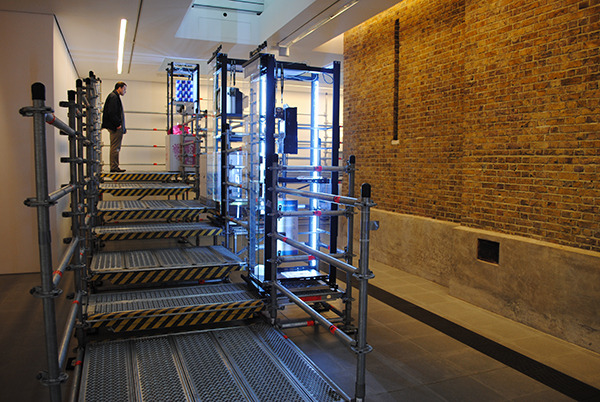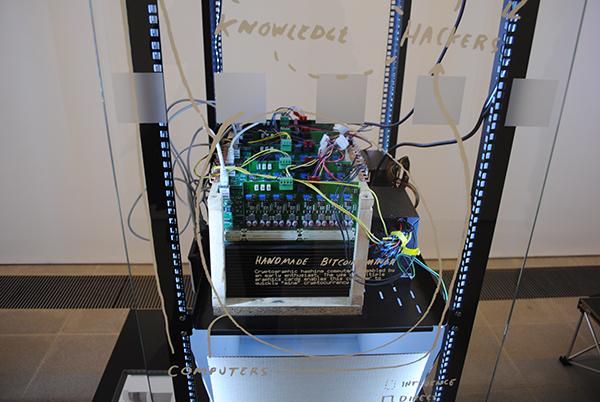Artlyst recently attended the Serpentine Sackler Gallery to see the latest work of Simon Denny. The artist incorporates print, graphics, moving images and texts, with an obsessional interest in modes of information, hackers, corporations – and models of information – all amassed into sculptural installations, and inserted ready-mades. This exhibition is the first solo show of the young New Zealand artist’s work in London.
Denny has rigged an installational series of works in the gallery resembling the wiring of some covert hacker’s den – filled with scaffolding to climb, plugs, blinking lights, screens and diagrams. There are vitrines filled with faux-circuitry, wiring, objects, texts – you name it – after all this is a very assemblage-based show, and maybe it should be in this complex information age? with works like updated Beuysian vitrines blended with server stacks, the artist certainly seems to think so.
 Image: Simon Denny, Products For Organising, installation detail, Serpentine Sackler, 2015. Photo: P A Black © Artlyst 2015.
Image: Simon Denny, Products For Organising, installation detail, Serpentine Sackler, 2015. Photo: P A Black © Artlyst 2015.
With the idea of varying forms of graphic: flowcharts and vitrine-entombed models, portraying varying aspects of seemingly opposing hierarchies – hackers, corporations, all involved in the creation, manipulation and control of information, and personal identities – even corporate ones: Apple and the hacker are intertwined in a mass of blinking cables.
A lot of the artist’s works are inspired by the circular floor plans of the three organisations’ iconic headquarters: Zappos and Apple, alongside the Government Communications Headquarters (GCHQ). Denny creates models of thought out of the architectural plans of these establishments forming a relationship with the sprawling minutia of information and the macro-expanse of the outside world; fusing both structures together. The model is all – how it impacts on everything – sculpturally in terms of architecture and our environment, and conceptually in terms of models of information and how they manipulate.
 Image: Simon Denny, Products For Organising, installation detail, Serpentine Sackler, 2015. Photo: P A Black © Artlyst 2015.
Image: Simon Denny, Products For Organising, installation detail, Serpentine Sackler, 2015. Photo: P A Black © Artlyst 2015.
There is a terrifying allusion to uneven hierarchies, the pyramidal structure of power and information of which the greater majority of viewers will find themselves at the bottom. Corporate models for thought, and imposed structures are only weakened by the artist’s inclusion of scaffolding to elevate the viewer above these oppressive concepts. We stand above these whirring two-dimensional environs as three-dimensional beings in jeopardy.
This is a visually exciting exhibition, if a little overwrought with assemblage, although one must confess that this complex and overt language-structure at least mirrors its subject matter, and is therefore perhaps rather apt as a dystopian conglomeration of models for control, where the spirit of freedom is tied to the gallery floor with a mass of Duchampian wiring.
About the artist:
Simon Denny (born 1982 in Auckland, New Zealand) has risen to critical acclaim with his work New Management (2014) and most recently with the installation Secret Power (2015), New Zealand’s pavilion for the 56th Venice Biennale. Denny is one of the leading figures of a generation of artists who employ content from the tech industry, the language of advertising and the aesthetics and ideologies of corporations or government bodies to scrutinise technology’s role in shaping global culture. With the precision of an investigative journalist, Denny’s complex and layered installations translate the often problematic histories and events associated with management and governance into visual form. His work challenges numerous themes which are rooted in modern society’s globalised cultures of technology, consumerism, organisation and the dissemination of information.
Lead image: Simon Denny, Products For Organising, installation detail, Serpentine Sackler, 2015. Photo: P A Black © Artlyst 2015.
Words: Paul Black. Photos: P A Black © Artlyst 2015.
Simon Denny: Products for Organising – Serpentine Sackler – until 14 February 2016.

